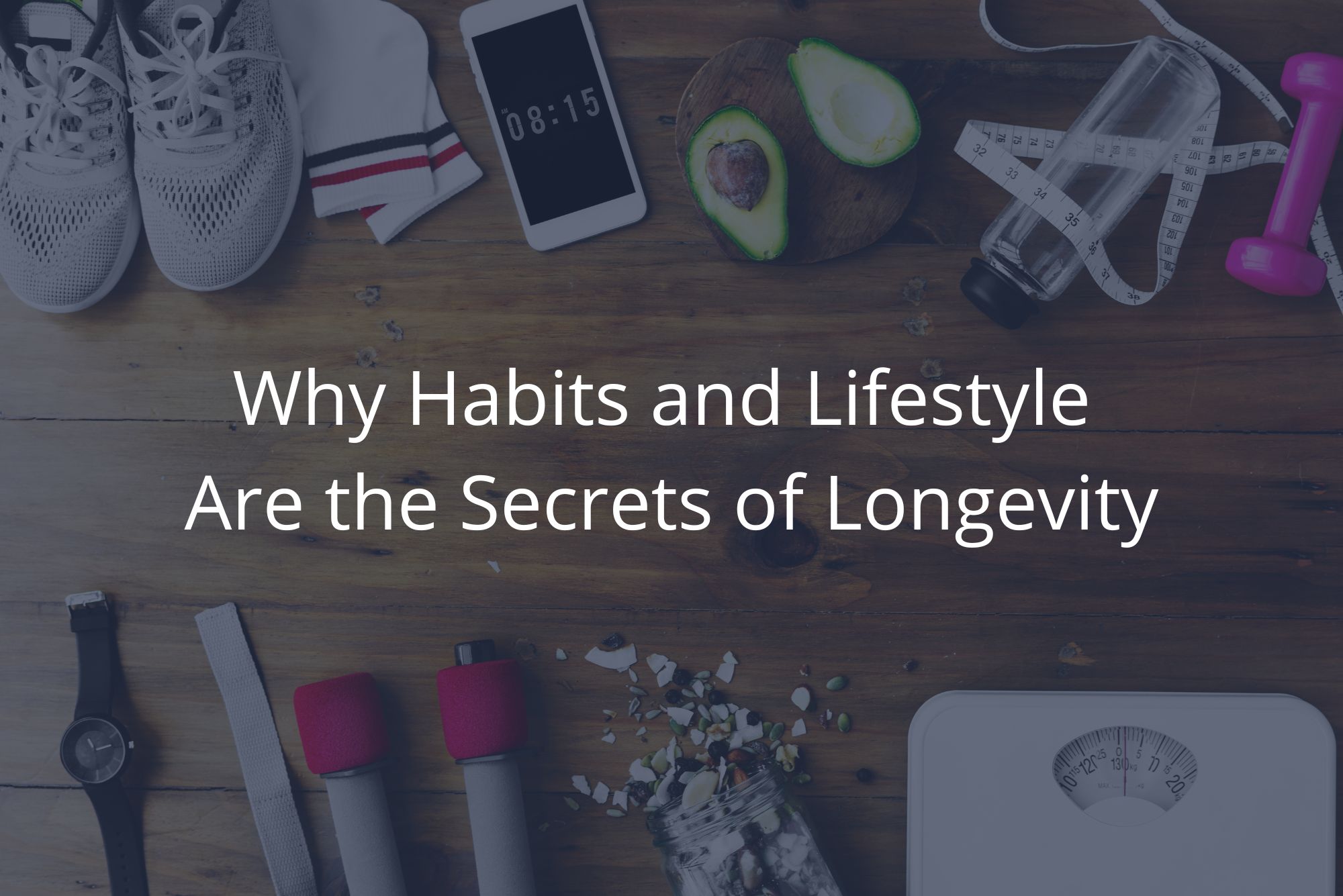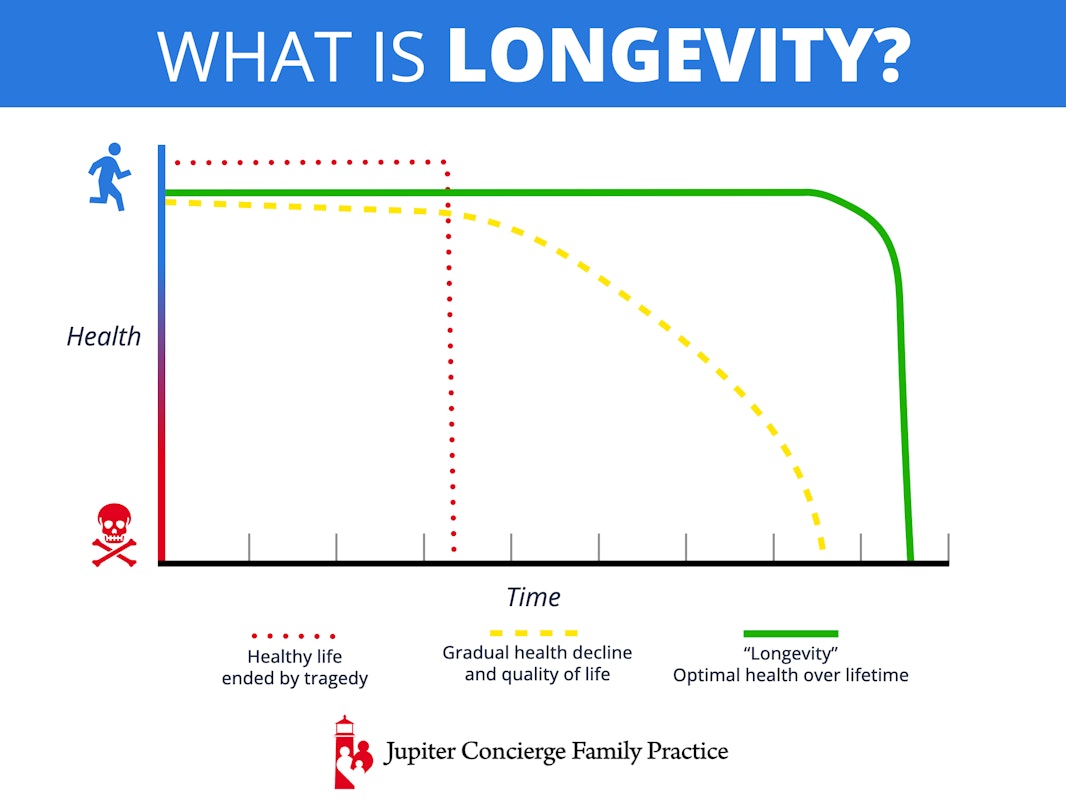
People have wide-ranging goals when it comes to personal health. Whether you’re a competitive athlete or a low-impact walker, however, most of us want the same thing in the end: longevity.
But what is longevity, and how do we attain it?
What Is Longevity?
As I see it, longevity is living a long, healthy life. The goal is to die as healthy as possible and live as long as possible.
Health, in turn, is not the absence of disease. It’s the preservation of a high quality of life. It means not letting your medical problems or medical issues get in the way of the things you want to do in this life.
Let me show you what I mean by walking you through this graphic:

The vertical axis is Health, while the horizontal axis is Time. Over time, human health declines, eventually leading to death. That’s a fixed aspect of human reality. The question is, what kind of flexibility do we have within that reality?
The red dotted line signifies a “healthy” human life that ends too soon. This is someone who presents as healthy, but suffers a lethal tragedy, usually the result of their own crazy behavior. This might be a person who is robustly healthy, but drives recklessly and dies in a wreck.
The yellow dashed line is what happens to most people. We start out healthy, but develop bad habits over time. At first, this doesn’t cause noticeable problems, but over time, those bad habits accumulate and catch up to us. Eventually, they turn into disease processes that worsen our quality of life. The end result is death.
I’ve heard some people say, “I’d rather die young than suffer from poor health for decades!” I’m here to tell you that you don’t have to do either.
Let’s look at the green line, which is what I mean by “longevity.” Notice how that line stays high on the Health axis. While death is inevitable, the decline isn’t a continual leaking drain over time. Your body should be able to work very well until your 80s. I always say that after 90, whatever happens happens. But until then, there’s so much healthy, satisfying living our bodies can do.
Pursuing Longevity in a Quick-Fix World
I know this post is called “Why Habits and Lifestyle Are the Secrets of Longevity,” but the naked truth is, there are no secrets to longevity. It’s a tale as old as time, and it’s unmoved by quick fixes. The modern-day “pill for an ill” mentality will not yield healthy, meaningful longevity. Only care and attention can do that.
Good things come to those who wait.
There’s no such thing as a free lunch.
Nothing worthwhile comes easy.
Diamonds take time.
Each of these sayings has merit when it comes to healthful longevity.
The good news is, there is no secret. The bad news is, there is no secret. What, then, can you do to promote longevity? You can organize and discipline your habits around the 4 Pillars of Health, consistently and over time.
The 4 Pillars of Health
- Regular Exercise
- Diet
- Sleep
- Stress Avoidance
Each pillar contains virtually endless topics and approaches that can help with longevity and overall quality of life. For now, I want to call out a few specific ideas you can use to your immediate benefit.
Personal relationships. Consider the quality of your interpersonal relationships. These can be both at home and at work. Relationships not only give us our deepest sense of joy and fulfillment, but they also lower stress hormones. Or, depending on the quality of these relationships, raise our stress hormones. Relationships directly affect many aspects of our health, both positively and negatively.
Intermittent fasting. This disciplined way of eating increases insulin sensitivity — another way of saying it decreases insulin resistance. When you’re more sensitive to insulin, there is less inflammation in your body. Too much inflammation is directly related to increased dysfunction and disease.
Intermittent fasting as a term can sound intimidating, but it’s doable for most people. Simply eat/drink nothing at all for 14–16 hours per day (besides water). If your supper ends at 8 p.m., for example, you wouldn’t eat anything until at least 10 a.m., or preferably noon, the next day.
Avoiding harm. So much can be gained by avoiding destructive behaviors. Steering clear of smoking, excessive alcohol consumption, and chronically negative people is good for your health.
Conclusion
There’s no doubt about it: The lifestyle habits you maintain are the key to achieving a long, healthy life. It all comes down to what you avoid and what you maximize over time.
Simple, repeated behaviors like eating as many different-colored vegetables as possible, avoiding sugar and processed foods, and engaging in some type of daily movement are game-changing habits. I’d also add not taking yourself too seriously to that list.
Keeping life as light as we can is a great way to increase both our enjoyment of it and its length. We can’t change that our lives will end, but we can influence how they’ll end.

Dr. David Rosenberg
Dr. Rosenberg is a board-certified Family Physician who obtained a BS in Chemistry at Georgia's Mercer University in 1983 and a medical degree from the University of Miami in 1988. He completed his residency in Family Medicine at The Washington Hospital in Washington, Pennsylvania, in 1991 and then practiced Emergency Medicine at Palm Beach Gardens Medical Center for two years. In 1993 he started private practice in Jupiter.
Dr. Rosenberg has been married to his wife Mary for 38 years and they have three grown children together. Some of his interests include being a huge baseball fan, sailing, snow skiing, self-development, and learning to play piano.
